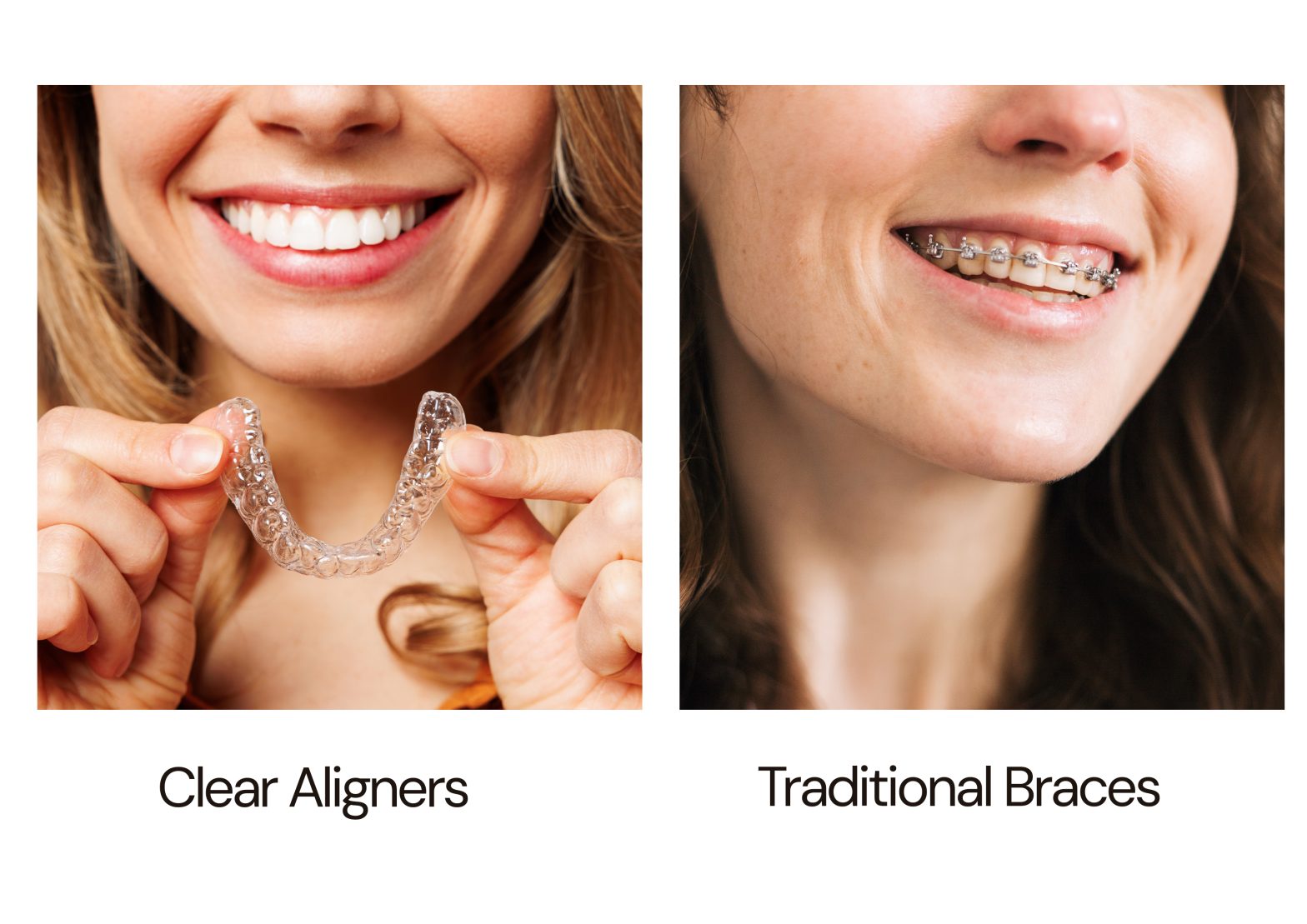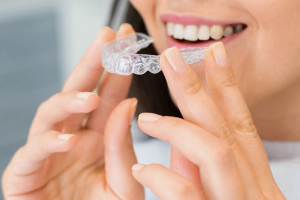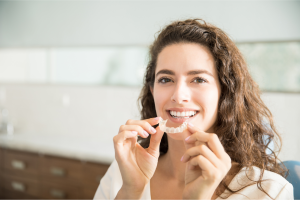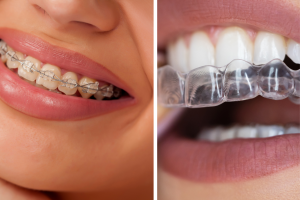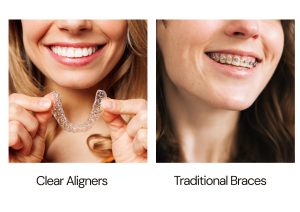Choosing between clear aligners and fixed braces is easier when you compare what matters day-to-day: comfort, appearance, hygiene, treatment time, and total value. This guide explains the differences clearly and shows where each option works best. You’ll also find links to relevant pages on our site so you can take the next step with confidence.
At a glance: what’s the main difference?
- Clear alignersare removable, transparent trays. They’re virtually invisible and designed from a 3D scan to move teeth in small, planned steps.
- Fixed bracesuse brackets and wires attached to the teeth. They are versatile and can handle a wide range of tooth movements.
Both systems can produce excellent results when treatment is properly planned and monitored. The best choice depends on your goals, your bite, and how you prefer to live day-to-day.
Comfort and appearance
- Clear aligners: Smooth trays reduce rubbing on lips and cheeks. Pressure is most noticeable during the first 24–48 hours after switching to a new set. They’re very discreet in photos and conversations, which is why many professionals choose them.
- Fixed braces: Modern braces are smaller than they used to be, but brackets and wires can cause occasional irritation and require wax or adjustments. Ceramic brackets look subtler than metal but are still visible
Prefer a low-profile, camera-friendly option? Book an appointment with us and explore options.
Eating, drinking, and everyday life
- Clear aligners come out for meals and for hot or coloured drinks. That means no diet restrictions and easier brushing/flossing afterward. To keep trays clear and odour-free, rinse, brush, and re-insert promptly.
- Fixed braces stay on during meals. Hard, sticky, or crunchy foods are limited to protect brackets and wires. Cleaning takes longer because food can lodge around fittings.
Hygiene and oral health
- Clear aligners: Because trays are removable, you brush and floss normally. This helps control plaque and reduces the risk of decalcification marks sometimes seen around brackets.
- Fixed braces: Excellent hygiene is achievable with care, but it requires more time and tools (interdental brushes, floss threaders, water flossers). Regular reviews are essential to keep gums healthy throughout treatment.
Predictability and case types
- Clear aligners handle a wide array of goals: mild–moderate crowding, spacing, and selected bite refinements. Many adult patients seeking front-tooth alignment find aligners ideal—especially for work and social events. Complex movements can still be planned with aligners in many cases, sometimes using attachments and elastics.
- Fixed braces remain the most versatile tool for large movements, significant bite changes, or scenarios where very precise root positioning is required. In those situations, braces can reach the goal more directly.
Not sure where your case sits? Book a clinical assessment and 3D scan; we’ll show a digital preview and an estimated plan: Book a Proaligners session with our dentist.
Treatment time and reviews
Timelines depend on your bite and wear consistency.
- Clear aligners: Many mild cases finish in 4–8 months; moderate cases commonly run 8–14 months. Reviews are short and scheduled to keep you on track. Refinements—extra trays that perfect the finish—are a normal part of modern aligner care.
- Fixed braces: Complex changes can run longer, but braces can also be efficient for certain movements. Review visits typically involve wire changes and adjustments.
Want a clear plan with tray count and milestones? Book Our High Class Dentists
Cost and value in London
Comparing the invisible braces cost in London and the cost of fixed braces only works when you compare like-for-like inclusions. Focus on total value:
- Clinical consultation and 3D scan
- Planned number of alignersor adjustments
- Attachmentsand IPR (when indicated)
- Review appointments and emergency support
- Refinementsto perfect the finish
- Retainersand post-treatment checks
- Optional extras such as whitening after treatment
Our packages are transparent and easy to read. Explore options here: Pricing.
Who tends to prefer clear aligners?
- Adults seeking discreet treatment for professional or social reasons
- Patients focusing on front-tooth alignment(crowding or spacing)
- Those who value removability, easier hygiene, and flexible mealtimes
- People comfortable wearing trays 20–22 hours daily to keep progress steady
Research terms that can help during your decision: clear aligners vs braces in London, best clear aligners for adults in London.
Safety and clinical oversight
At Pro Aligners, treatment is clinician-led from assessment through retention. Movement stays within biological limits, gum health is monitored, and bite relationships are reviewed throughout. Attachments and IPR—when indicated—are explained in plain language before you start.
Frequently Asked Questions
Will people notice clear aligners?
They’re transparent and low-profile. Most patients report they’re barely visible in everyday conversation.
Do clear aligners hurt?
Expect pressure for 24–48 hours after changing trays. This settles quickly and can be managed with standard comfort measures.
Can I drink coffee or tea?
Remove trays for hot or coloured drinks to prevent warping and staining. Rinse and brush before re-inserting.
How do retainers work after treatment?
Retainers hold teeth in their new positions. We provide a tailored plan and explain fixed vs removable options during your finish appointment.
This article supports informed decision-making and complements a clinical exam. A dentist will confirm suitability and design a plan tailored to your goals.
